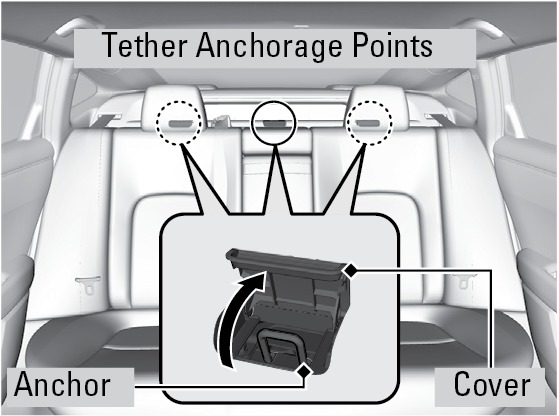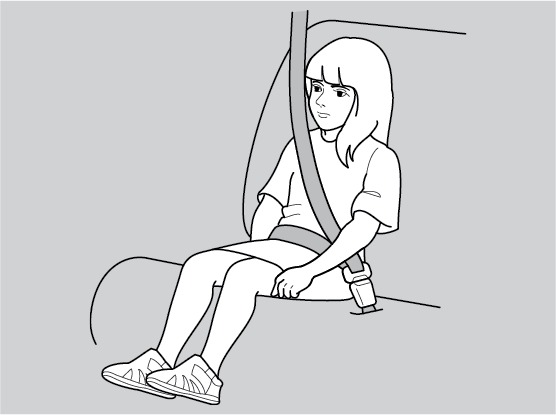Protecting Child Passengers
- An inflating front or side airbag can injure or kill a child sitting in the front seat.
- A child in the front seat is more likely to interfere with the driver's ability to safely control the vehicle.
- Statistics show that children of all sizes and ages are safer when they are properly restrained in a rear seat.
- Any child who is too small to wear a seat belt correctly must be restrained in an approved child seat that is properly secured to the vehicle using either the lap belt portion of the lap/shoulder belt or the lower anchors of the LATCH system.
- Never put a seat belt over yourself and a child. During a crash, the belt would likely press deep into the child and cause serious or fatal injuries.
- Never let two children use the same seat belt. Both children could be very seriously injured in a crash.
- Do not allow children to operate the doors, windows, or seat adjusters.
- Do not leave children in the vehicle unattended, especially in hot weather when the inside of the vehicle can get hot enough to kill them. They could also activate vehicle controls, causing it to move unexpectedly.
Children who are unrestrained or improperly restrained can be seriously injured or killed in a crash.
Any child too small for a seat belt should be properly restrained in a child seat. A larger child should be properly restrained with a seat belt, using a booster seat if necessary.
Allowing a child to play with a seat belt or wrap one around their neck can result in serious injury or death.
Instruct children not to play with any seat belt and make sure any unused seat belt a child can reach is buckled, fully retracted, and locked.
Protecting Infants
An infant must be properly restrained in a rear-facing, reclining child seat until the infant reaches the seat manufacturer's weight or height limit for the seat and the infant is at least one year old. Many experts recommend use of a rear-facing seat for a child up to two years old if the child's height and weight are appropriate for a rear-facing seat.
Child seats must be placed and secured in a rear seating position. Rear-facing child seats should never be installed in a forward-facing position.

When properly installed, a rear-facing child seat may prevent the driver or a front passenger from moving their seat all the way back or from locking their seat-back in the desired position. Make sure that there is no contact between the child seat and the seat in front of it. It can also interfere with proper operation of the front passenger's advanced front airbag system. If this occurs, we recommend that you install the child seat directly behind the front passenger's seat, move the seat as far forward as needed, and leave it unoccupied. Or you may wish to get a smaller rear-facing child seat.
Placing a rear-facing child seat in the front seat can result in serious injury or death during a crash.
Always place a rear-facing child seat in the rear seat, not the front.
Protecting Smaller Children
If a child is at least one year old and within the weight range indicated by the child seat manufacturer, the child should be properly restrained in a firmly secured forward-facing child seat.

We strongly recommend placing a forward-facing child seat in a rear seating position.
Placing a forward-facing child seat in the front seat can be hazardous, even with advanced front airbags that automatically turn the passenger's front airbag off. A rear seat is the safest place for a child.
Placing a forward-facing child seat in the front seat can result in serious injury or death if the front airbag inflates.
If you must place a forward-facing child seat in front, move the vehicle seat as far back as possible and properly restrain the child.
Selecting a Child Seat
Most child seats are LATCH-compatible (Lower Anchors and Tethers for CHildren). Some have a rigid-type connector, while others have a flexible-type connector. Both are equally easy to use. Some existing and previously owned child seats can only be installed using the seat belt. Whichever type you choose, follow the child seat manufacturer's use and care instructions as well as the instructions in this manual. Proper installation is key to maximizing your child's safety.
In seating positions and vehicles not equipped with LATCH, a LATCH-compatible child seat can be installed using the seat belt and a top tether for added security. This is because all child seats are required to be designed so that they can be secured with a lap belt or the lap part of a lap/shoulder belt. In addition, the child seat manufacturer may advise that a seat belt be used to attach a LATCH-compatible seat once a child reaches a specified weight. Please read the child seat owner's manual for proper installation instructions.
Important considerations when selecting a child seat
Make sure the child seat meets the following three requirements:
- The child seat is the correct type and size for the child.
- The child seat is the correct type for the seating position.
- The child seat is compliant with Federal Motor Vehicle Safety Standard 213 or Canadian Motor Vehicle Safety Standard 213.
Children who are unrestrained or improperly restrained can be seriously injured or killed in a crash.
Any child too small for a seat belt should be properly restrained in a child seat. A larger child should be properly restrained with a seat belt, using a booster seat if necessary.
Installing a LATCH-Compatible Child Seat
A LATCH-compatible child seat can be installed in either of the two outer rear seats. A child seat is attached to the lower anchors with either the rigid or flexible type of connectors.
- Locate the lower anchors under the marks.

- Place the child seat on the vehicle seat, then attach the child
seat to the lower anchors according to the instructions that came
with the child seat. Make sure that the lower anchors are not obstructed
by the seat belt or any other object.


- Open the tether anchor cover behind the head restraint.
- For straight top tethers: Route the tether over the top
of the head restraint.
For other top tethers: Route the tether around the head restraint.
For all types: Secure the tether hook to the anchor.

- Tighten the tether strap according to the seat manufacturer's instructions.
- Make sure the child seat is firmly secured by rocking it forward and back and side to side; little movement should be felt.
- Make sure any unused seat belt that a child can reach is buckled, the lockable retractor is activated, and the belt is fully retracted and locked.
Installing a LATCH-compatible child seat in the rear center seat
Each outer rear seat is equipped with a pair of lower anchors which are used to secure a LATCH-compatible child seat. The rear center seat, however, is not equipped with anchors of any kind.
The inner and outer anchors are spaced apart at a standard distance of 11 inches (280 mm). The distance between the two inner anchors is 15.7 inches (400 mm).
LATCH-compatible restraint systems that are fitted with rigid-type attachments cannot be installed in the rear center seat. However, a system fitted with flexible-type attachments can be installed in the center seat, provided that the manufacturer's instructions for that system permit the use of the inner anchors with the stated spacing.
Before seating a child, make sure that the system is properly attached to both the lower anchors and tether anchors.
Installing a Child Seat with a Lap/Shoulder Seat Belt
A child seat can be installed with a lap/shoulder belt in any rear seat or, if absolutely necessary, the front passenger seat.
- Place the child seat on the vehicle seat.
- Route the seat belt through the child seat according to the seat
manufacturer's instructions and insert the latch plate into the buckle.
Insert the latch plate fully until it clicks.

- Slowly pull the shoulder part of the belt all the way out until
it stops. This activates the lockable retractor.

- Let the seat belt completely wind up into the retractor, then try to pull it out to make sure the retractor is locked. If you are able to pull the shoulder belt out, the lockable retractor is not activated. Pull the seat belt all the way out and repeat steps 3 - 4.
- Grab the shoulder part of the seat belt near the buckle and pull
up to remove any slack from the lap part of the belt. When doing this,
place your weight on the child seat and push it into the vehicle seat.

- Make sure the child seat is firmly secured by rocking it forward
and back and side to side; less than one inch of movement should occur
near the seat belt.

- Make sure any unused seat belt that a child can reach is buckled,
the lockable retractor is activated, and the belt is fully retracted
and locked.
To deactivate a lockable retractor, release the buckle and allow the seat belt to wind up all the way.
Adding Security with a Tether
A tether anchorage point is provided behind each rear seating position. A child seat that is installed with a seat belt and comes with a tether to use for additional security.
- Locate the appropriate tether anchorage point and lift the cover.

- Straight top tether: Route the tether strap over the head
restraint. Make sure the strap is not twisted.
Other top tether: Route the tether strap around the head restraint. Make sure the strap is not twisted.

- Secure the tether strap hook onto the anchor.

- Tighten the tether strap according to the child seat manufacturer's instructions.
- Using the center anchor: Locate the appropriate tether anchorage point and lift the cover.
- Raise the head restraint to its highest position, then route the
tether strap through the head restraint legs. Make sure the strap
is not twisted.

- Secure the tether strap hook to the anchor.
- Tighten the tether strap according to the child seat manufacturer's instructions.
Protecting Larger Children
When a child is too big for a child seat, secure the child in a rear seat using the lap/shoulder seat belt.
Have the child sit upright and all the way back, then ensure the following:

- The child's knees bend comfortably over the edge of the seat.
- The shoulder belt crosses between the child's neck and arm.
- The lap part of the seat belt is as low as possible, touching the child's thighs.
- The child can stay seated for the whole trip.
If a lap/shoulder belt cannot be used properly, position the child in a booster seat in a rear seating position. For the child's safety, check that the child meets the booster seat manufacturer's recommendations.
Some U.S. states and Canadian provinces/territories require children to use a booster seat until they reach a given age or weight (e.g., 6 years or 60 lbs). Be sure to check current laws in the state or province/territory where you intend to drive.
Allowing a child age 12 or under to sit in the front can result in injury or death if the passenger's front airbag inflates.
If a larger child must ride in front, move the vehicle seat as far to the rear as possible, then have the child sit up properly and wear the seat belt properly, using a booster seat if needed.